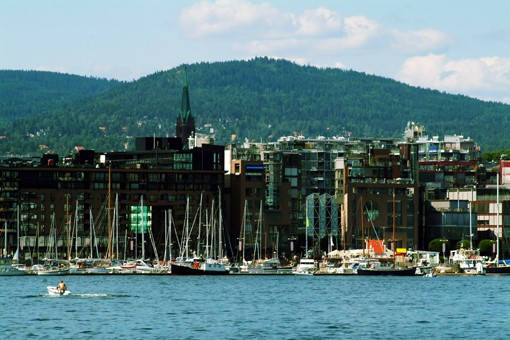 Whether you’re looking for an Oslo hotel in the heart of the city, in leafy Frogner or in trendy Grünerløkka, this guide will help you decide where to stay in Oslo.
Whether you’re looking for an Oslo hotel in the heart of the city, in leafy Frogner or in trendy Grünerløkka, this guide will help you decide where to stay in Oslo.Leading west from Oslo’s main train station to the Royal Castle, Karl Johans Gate is Oslo’s main street. Its lower end is a pedestrianised shopping area, while the stretch from the Parliament to the palace, both neoclassical in style, is lined with stately buildings. Many of Oslo’s most luxurious hotels can be found here. Whether it’s theatre-goers mingling outside the National Theatre, punters enjoying a meal at one of the many outdoor terraces (even when the mercury drops below zero), or Oslo Cathedral’s bells ringing on a Sunday morning, downtown is always noisy and lively.
Near Oslo S and the Opera
This formerly run-down area around Oslo’s main rail terminal has been experiencing a revival since the opening of Oslo’s opera, a striking vision in white marble and glass. Enjoy the view over the Oslofjord from the rooftop, or catch the Norwegian National Opera perform in the oak-panelled, state-of-the-art auditorium. This area is central and convenient for transport, nightlife and shopping – two of Oslo’s biggest shopping centres are located here.
Akershus Fortress and Kvadraturen
This neighborhood south of Karl Johans Gate, between the opera and Oslo’s harbour, is one of Oslo’s oldest, and is dominated by the Akershus Festning, Oslo’s medieval fortress. The pace of life here is somewhat slower, and the area is best explored on foot. You can see works by the likes of Charles Ray, Jeff Koons or Damien Hirst at the Astrup Fearnley Museum of Modern Art, or marvel at the 100 scale models of Norwegian buildings on display at the nearby Architecture Museum. The area around Christiania Torv in Kvadraturen is home to some of Oslo’s oldest restaurants. From there it’s only a short walk down to the harbour, Aker Brygge and City Hall.
These two residential areas behind the Royal Palace in the western part of the city are leafier and posher, than many other Oslo districts. You will find several B&Bs and guesthouses here, as well as Vigeland Sculpture Park. Covering 80 acres and featuring more than 200 bronze and granite sculptures, the park is one of Oslo’s most popular attractions, and an ideal picnic spot in summer, with vast expenses of grass and a huge playground. If gourmet restaurants, upmarket boutiques and small cutting-edge galleries are what you’re after, Frogner and Majorstuen will fit the bill.
If you are looking for something different, try one of these two districts to the east of Akerselva. Vibrant Grønland, just north of Oslo S, the main train station, has a very multicultural feel, with ethnic restaurants and shops selling tantalising assortments of exotic-looking roots, fresh herbs, fragrant spices, olives and dried fruits, as well as rice in 20kg bags. Locals are just as likely to have Pakistani, Polish or Vietnamese as their first language as Norwegian. Meanwhile, Grünerløkka, traditionally a working-class district, has become gentrified of late, with small boutiques, art galleries and trendy cafés popping up everywhere.